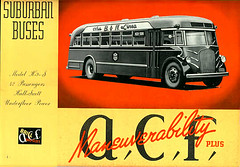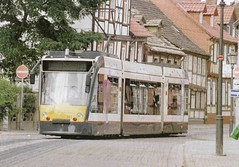Use it or lose it or you have to recreate it (U.S. streetcar technology and expertise)
 Advertisement for ACF Brill Model H-9-S Suburban Motor Coach. ACF, which stood for "American Car Foundry" manufactured railroad and streetcar equipment. They took up bus manufacturing as a strategy to stay in the transportation business in the face of the dissolution of the rail-based U.S. streetcar industry.
Advertisement for ACF Brill Model H-9-S Suburban Motor Coach. ACF, which stood for "American Car Foundry" manufactured railroad and streetcar equipment. They took up bus manufacturing as a strategy to stay in the transportation business in the face of the dissolution of the rail-based U.S. streetcar industry.Yesterday's Sprawl and Crawl column in the Examiner, "Are foreign parts cheaper for Metro?" asks why do area transit systems spend lots of money with foreign-based manufacturers, instead of keeping those good old American dollars and jobs at home?
The answer is simple really.
It's all about technological expertise. Because U.S. streetcar systems died off almost completely after WWII, the U.S.-based industry dried up, and the skill and knowledge base disappeared (cf. scholarship about technology and network effects by people such as AnnaLee Saxenian).
 Page from a General Electric handbook promoting their streetcar operations. (I wonder what happened to the GE archive of materials on streetcar manufacturing and marketing?)
Page from a General Electric handbook promoting their streetcar operations. (I wonder what happened to the GE archive of materials on streetcar manufacturing and marketing?)Meanwhile, European cities continued to use the technology. So the industry never withered away and in fact, continued to improve. The similar thing happened with passenger train equipment manufacturing in the U.S., witness the massive failure of brakes on the Acela Amtrak locomotives. So Skoda (Czech Republic) makes streetcar vehicles (among others), and French and German companies are known for maglev passenger trains, etc.
 Halberstadt (Germany): Short Combino LRV. Photo via Light Rail Now.
Halberstadt (Germany): Short Combino LRV. Photo via Light Rail Now.During the DC Streetcar study process I put the idea out that DC should try to develop a joint venture with Skoda to manufacture their modern streetcar vehicles in DC, to be located adjacent to the Ivy City railyard, which has WMATA and Amtrak maintenance facililties. Now with Dan Tangherlini at WMATA instead of DDOT (and Greg Walker, the original person at WMATA planning heading up their side of the effort is gone too) this "innovative" idea might be a bit difficult for the city government to grasp...
(Note that I think the system should be made to be interoperable so that heritage streetcars, or heritage-replica streetcars can run on the same system. Heritage streetcar replica vehicles are manufactured in the U.S. See the paper Bring Back the Streetcars for more information.)
Remember that Amtrak, because it is based here, and has big facilities, is actually an important part of the economic development equation in the city of Washington.
This is similar to the recent venture in New Orleans where cars for the new Canal streetcar line were built in New Orleans in a such a combination. (I had intended to tour this facility this month, but Katrina put a kibosh on that plan. I hope I can do so in June.) In fact, it's something I talked with Greg Walker about...
 New Orleans, Canal Streetcar Line. Photo from the Heritage Trolley website.
New Orleans, Canal Streetcar Line. Photo from the Heritage Trolley website.If DC is to install 8 (or more) streetcar lines + Columbia Pike in Arlington and if Baltimore decides to use the same technology (they are planning, or at least talking about putting a streetcar line in on Charles Street), some level of critical mass can be achieved, and the beginnings of redeveloping a U.S. cluster of expertise in streetcar technology and manufacturing is possible, but one that can be centered in the Baltimore-Washington region.
If Virginia and Maryland use the same technology and are willing to participate in a local manufacturing effort, perhaps some form of tripartite relationship could be created (similar to how Airbus was created by German, French, British, and Spanish companies), where DC would be the dominant partner, because it is making a far greater financial commitment to streetcar use than the other jurisdictions.
In some respects transit is one of the last industries (besides real estate construction) present in cities. Here is an opportunity to leverage that fact.
Index Keywords: transit



0 Comments:
Post a Comment
<< Home